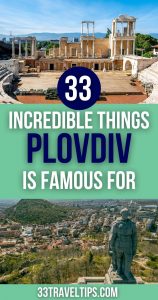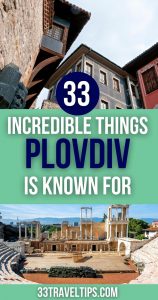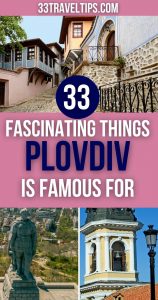
Plovdiv is known for its ancient Roman Theater, winding cobblestoned streets, quirky Old Town, the seven hills it sits upon, and the longest pedestrian street in Europe. Plovdiv is also famous for its red wine production, the colorful Kapana District, and for being the oldest city in Europe.
In this guide, you’ll learn 33 amazing things Plovdiv is known for.
From beautifully preserved 19th-century townhouses to jaw-dropping city views, and from peculiar museums to the gorgeous Maritsa River, we bet you’ll discover why is Plovdiv famous.
Fasten your virtual seatbelts, and let’s jump in!
The Landmarks Plovdiv Is Known For
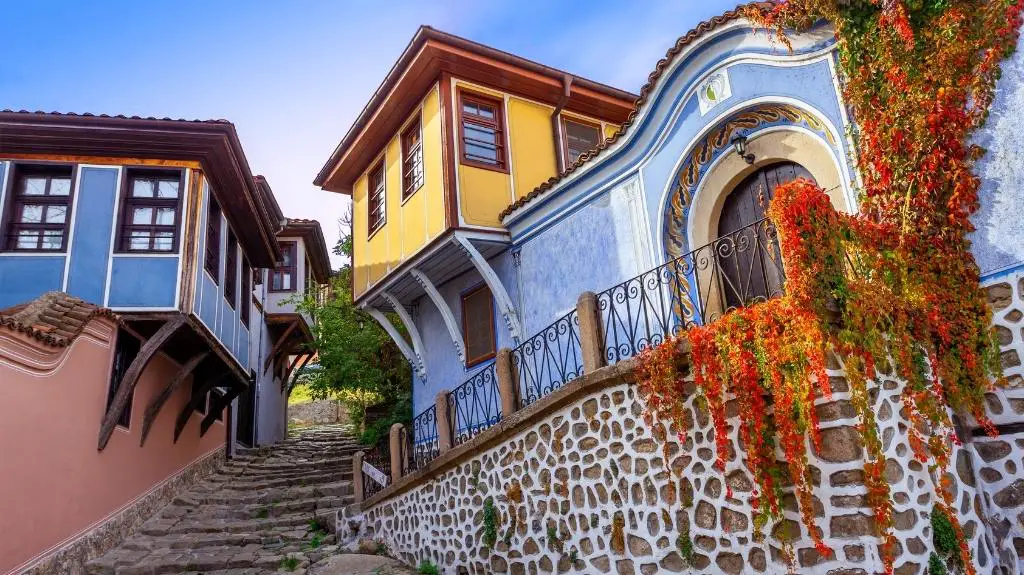
Plovdiv’s old name was Philippopolis. So, in the attractions below, you’ll find many that bear the city’s Roman name. With that said, let’s check the beautiful landmarks Plovdiv is famous for.
- The Old Town. Winding cobblestoned streets. Heart-stopping views of the city. Drop-dead gorgeous 18th– and 19th-century houses. If there’s one thing that you shouldn’t miss when visiting Plovdiv, it’s the breathtaking Old Town. Within its limits, you’ll discover peculiar museums, Roman stadiums, ancient amphitheaters, and numerous art galleries. Even wandering its cobble stones is enough to give you a sense of the one-of-a-kind atmosphere of this glorious place.
- The Ancient Theater. Plovdiv’s most famous cultural landmark is its ancient Roman amphitheater. You’ll discover it in a jaw-dropping position on a hill in the Old Town. Domestic and international guests can enjoy performances while sitting on ancient marble seats. The fact that the Ancient Amphitheater overlooks the whole city center, with the Rhodope Mountains at the background, adds more beauty to its splendor. Just be careful when walking around as the steps are quite steep.
- Odeon of Philippopolis. The Odeon of Philippopolis once served as the City Council of Citizens in ancient Plovdiv. The Romans also used the building as a theater. The existence of such an edifice in ancient Plovdiv indicates the importance of Philippopolis as a cultural and political center. Discovered in 1988, the city council listed the monument as a cultural value of national significance.
- Stadium of Philippopolis. The ancient Roman Stadium of Philippopolis dates back to the Roman Imperial Period in the 2nd century AD. When the stadium was erected, Philippopolis was the capital of the ancient Roman province of Thrace. The gigantic stadium is 820 ft. (250 m) long and 160 ft. (50 m) wide, and could seat around 30,000 spectators.
- Kapana District. Arts and cultures characterize Kapana – Bulgaria ’s first creative district. Cobblestoned streets take you to numerous art galleries, crafts shops, and restored buildings. A wide variety of bakeries, gastropubs, and funky eateries serve everything from traditional dishes to French cuisine. The famous Kapana Fest takes place every year and showcases artists, performers, and the iconic for the district’s street decorations.
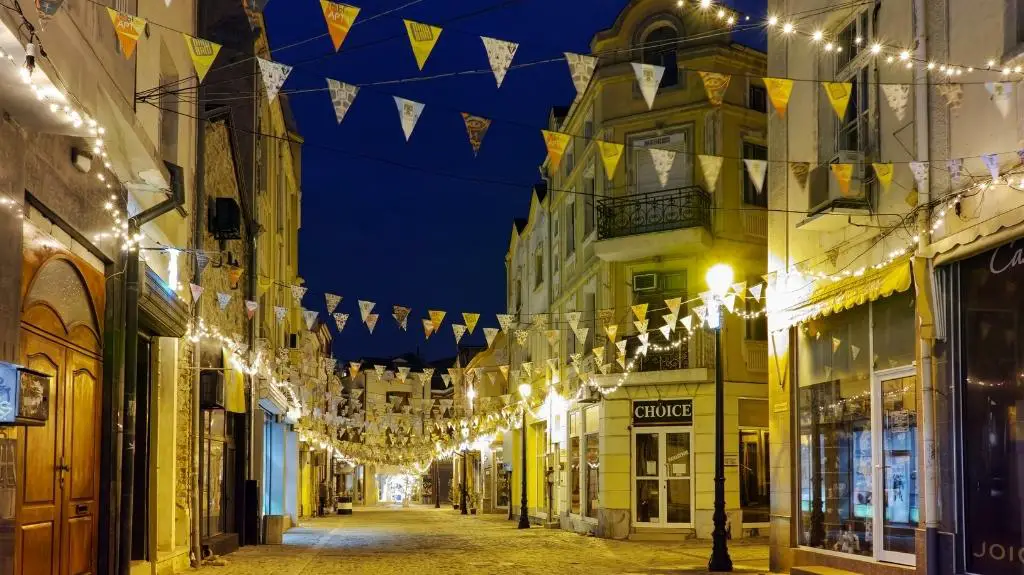
- The Maritsa River. The mighty Maritsa River might be unnavigable, but it’s one of the largest rivers in Europe by discharge. Eons ago, it was also the main river of the ancient Thracians. Today, six bridges connect the northern with the southern part of Plovdiv. Around the river bed, you can find dozens of lush parks and bike lanes.
- Tsar Simeon Park. The Swiss landscape architect Lucien Chevalas created Tsar Simeon Park in 1892. Inside, you can admire the restored fountain of the Olympian Goddess Demeter. The park is also home to an opulent Viennese pavilion. The pearl in Tsar Simeon Park’s crown are the Singing Fountains, which you can read about in the next tip.
- The Singing Fountains. Summers in Plovdiv are boiling hot. So, a good way to cool down is to hang around the Singing Fountains in Tsar Simeon Park. Besides their cooling effect, you’ll witness a spectacular show with music and lights. The fountains “dance” every Thursday, Friday, and Saturday evening at 9:30 PM. Grab a beer, arrive a bit early to save your spot, and enjoy the show.
- Statue of Milyo the Crazy. One of Plovdiv’s most “Instagrammable” places is the stairs with water cascades on the main pedestrian street. On the right side, you’ll find a small bronze statue of the Bohemian Milyo Ludiya (Milyo the Crazy). Milyo was mentally unstable, but he made people laugh with his unadulterated jokes. Some say Milyo was very smart and spoke several languages, but he lost his mind by reading too much. Whether that’s true or not, we don’t know for sure. But we recommend taking a photo with his statue and touching his knees for good luck.
- Bachkovo Monastery. Bulgaria’s second-largest monastery is less than 30 minutes away from Plovdiv. In the mighty embrace of the Rhodope Mountains and on the right bank of the Chepelare River, you’ll find the Bachkovo Monastery. Established in 1083, the cloister uniquely combines Bulgarian, Byzantine, and Georgian culture that are united by the common Orthodox faith. The best way to explore the Bachkovo Monastery is to hop on a day trip. We highly recommend this one because it also includes wine tasting.
- Asen’s Fortress. On the way to the Bachkovo Monastery, you’ll pass by Asen’s Fortress. Overlooking the picturesque town of Asenovgrad, the fortress dates back to the 11th century. In 1231, Bulgarian tsar Ivan Asen II considerably renovated the fortification. The most notable feature of the medieval stronghold is the Church of the Holy Mother of God. A great way to visit both Asen’s Fortress and the Bachkovo Monastery is an organized guided tour. Click here to reserve your spot in advance.
The Religious Temples Plovdiv Is Known For
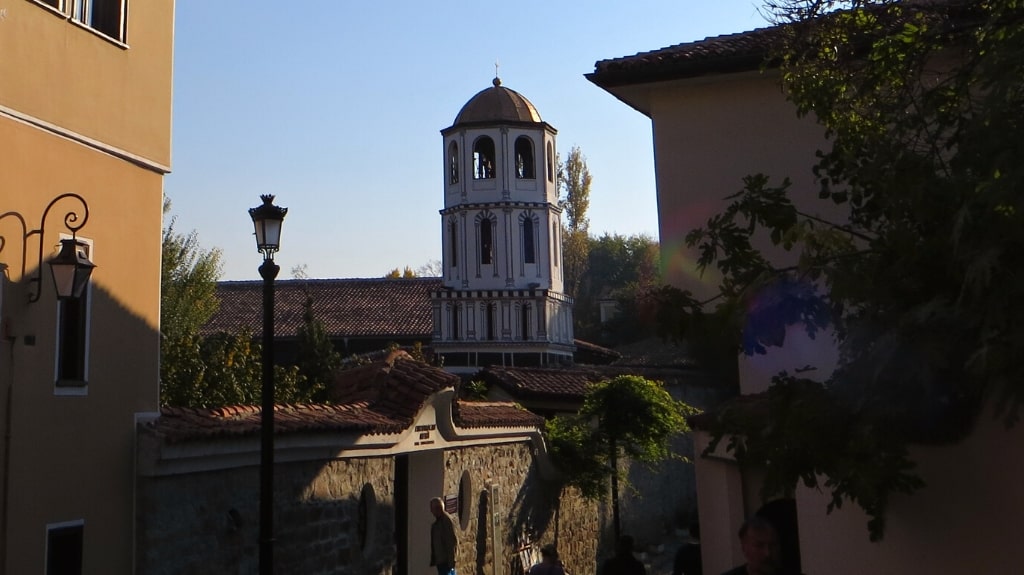
One of the best reasons Plovdiv is worth visiting is to discover its abundant history through the religious sites of the city. In the section below, you’ll find the places of worship Plovdiv is famous for.
- Small Basilica of Philippopolis. One of Plovdiv’s most iconic landmarks is the Small Basilica of Philippopolis. Locals discovered the remnants of the early Christian church during construction works in 1988. The basilica was erected in the 5th century AD. Originally constructed as a three-nave basilica, it’s a wonderful example of the genius skills of mosaic builders from ancient Philippopolis.
- Church of St. Constantine and Helena. Among the oldest churches in Plovdiv is the Church of St. Constantine and Helena. Constructed in 337, on the site of an ancient pagan temple, the church bears the names of Emperor Constantine the Great, and his mother Helena. Don’t miss the breathtaking frescoes and icons created by masters of the Debar School of Iconography.
- St. Louis Cathedral. The Cathedral of St. Louis in Plovdiv is one of Bulgaria’s largest and most significant Roman Catholic temples. The cathedral took its name from Louis IX of France, also known as St. Louis. When inside, don’t miss checking out the large organ. The building features a peculiar combination of Neo-Baroque and Neoclassicism architecture styles.
- Dzhumaya Mosque. The main Muslim temple in Plovdiv is the Dzhumaya Mosque. The Ottomans erected the temple on the site of a cathedral when they conquered Plovdiv in 1363-1364. The temple is among the oldest and largest Ottoman mosques on the Balkans. Nine domes support Dzhumayata’s roof, and the prayer hall measures 108 ft. x 89 ft. (33 m x 27 m).
- Dervish Monastery Mevlevi Hane. In Plovdiv’s Old Town, you can marvel at a Muslim monastery. Yep, you read that right. Mevlevi Hane is a dervish monastery. It derives its name from the Order of the Dancing Dervishes, also known as “mavlevii”. Legend has it once this place was a Christian church, which the Ottomans destroyed in 1410. Mevlevi Hane’s exterior is humble, but the interior is rich with carvings and frescoes.
The Museums Plovdiv Is Famous For

Similar to Sofia, Bulgaria’s second-largest city boasts dozens of museums that are worth visiting. In the section below, we’ll show you the most interesting museums Plovdiv is known for.
- Regional Ethnographic Museum. The Regional Ethnographic Museum in Plovdiv is the second-largest specialized museum of this kind in Bulgaria. Inside this colorful exhibition hall, you’ll have a chance to marvel at over 7,000 crafts items, 11,000 textile and clothing exhibits, and 5,000 musical and ritual instruments. The permanent exhibition showcases the cultures of Thracian Valley and the mountains Rhodopes and Sredna Gora.
- Plovdiv Aviation Museum. Although the idea for an aviation museum arose at the end of World War I, the Plovdiv Aviation Museum opened its doors in 1991. Located very close to Plovdiv Airport, the museum narrates the history and development of Bulgarian aviation and consists of two exhibitions – internal and external. Don’t miss the green military hydroplane Arado 196 A-3 “Shark” – the only remaining one in the world.
- Regional Archaeological Museum. With over 100,000 exhibits and artefacts, the Regional Archaeological Museum (RAM) boasts one of the richest collections related to the history of Plovdiv. One of the coolest facts about Plovdiv is that it’s the oldest city in Europe. That’s why inside RAM, you’ll find exhibitions that span all the way back to the Eneolithic and the Bronze Ages (5,000 – 1,000 years B.C.).
- House-Museum Hindliyan. The House of Stepan Hindliyan was erected in 1834-1835 by unknown builders. It remains one of the few houses in Plovdiv that have preserved their original symmetric design. Today, it acts as a museum and is one of the best Bulgarian Revival-style houses in the city. Stepan Hindliyan was a merchant who traded with India, Egypt, Italy, Portugal, and the Ottoman Empire.

- Balabanov’s House. Another house-museum worth visiting in the Old Town of Plovdiv is Balabanov’s House. You’ll marvel at extremely rich architecture details, as well as flat and plastic ornamentations. The house was built at the beginning of the 19th century by a rich Plovdiv merchant. Balabanov’s House was demolished in the 1930s, but the most prominent researcher of Renaissance houses reconstructed it in the 1970s.
- Regional National History Museum. The second-largest museum in Bulgaria harbors a modern exhibition with a heavy emphasis on the preservation of nature. The Regional National History Museum of Plovdiv is also home to a large library where you can find scientific publications in various languages, including Bulgarian, English, German, Russian, and others. Don’t miss the freshwater aquarium where you can discover over 30 different aquarium fish species and exotic plants.
- Zlatyu Boyadzhiev Permanent Exhibition. Plovdiv is known for being a city of painters. Among the most popular is Zlatyu Boyadzhiev who lived in the city in the 20th century. People are central in Boyadzhiev’s art as he loved Bulgaria and its folks. Today, you can marvel at the artist’s masterpieces in the Zlatyu Boyadzhiev Permanent Exhibition, which is housed in a gorgeous house that dates back to 1860.
- Art Gallery & Museum Philippopolis. Plovdiv’s Old Town is home to another emblematic institution. Art Gallery & Museum Philippopolis displays a private art collection that covers works of art from the Bulgarian Revival period to masterpieces of popular modern artists. When you get enough of paintings and art, quench your hunger in the museum’s gourmet restaurant that overlooks the artistic district of Plovdiv – Kapana.
- Cultural Center-Museum TrakArt. Inside the Cultural Center-Museum TrakArt, you can marvel at an ancient Roman mosaic that stems from the 3rd and 4th centuries AD. Don’t miss the “Glass in Ancient Art” exhibition that demonstrates the history of glass manufacturing from the 5th century BC to the 4th century AD. End your visit by checking the exhibition of Roman miniature portraits.
Curious Facts Plovdiv Is Famous For

From boasting the largest rowing channel on the Balkans to being the oldest city in Europe, let’s discover the most interesting facts Plovdiv is known for.
- Plovdiv is Europe’s oldest city. Bulgaria’s second-biggest city is Europe’s oldest continuously inhabited settlement. Historians and scientists argue about its exact age, but some reports claim it’s over 8,000 years old. That Plovdiv fact makes it one of the oldest cities worldwide. Thracians, Romans, and other ancient peoples resided on the territory of modern Plovdiv at different points in time.
- The longest pedestrian street in Europe is in Plovdiv. Besides being the oldest settlement in Europe, Plovdiv holds another record. The longest pedestrian street on the Old Continent is also in Plovdiv. It starts at the famous Trimontium Hotel, next to the Tsar Simeon Park, and stretches all the way to the Dzhumaya Square and the ancient Roman Stadium. Locals flock there to shop, stroll, or sit at the numerous outdoor cafés and restaurants.
- The country’s most popular red wine variety originates here. Bulgaria prides itself on some of the best red wines in the world. One of the most distinctive red wines in Bulgaria is Mavrud. And it originates from the small town of Asenovgrad that’s in Plovdiv’s vicinity. So, if you like red wine, don’t miss sipping a glass of the large, winged, and relatively heavy Mavrud. It goes well with red meats and various types of cheeses.
- The rowing channel is the largest of its kind on the Balkans. With its 2,2 km (1.37 mi) in length and 120 m (394 ft.) in width, the Rowing Channel in Plovdiv is the biggest facility of its kind on the Balkan Peninsula. You can discover the canal next to the Recreation and Culture Park. Jogging and walking alleys, as well as a cycling lane, surround the rowing channel.
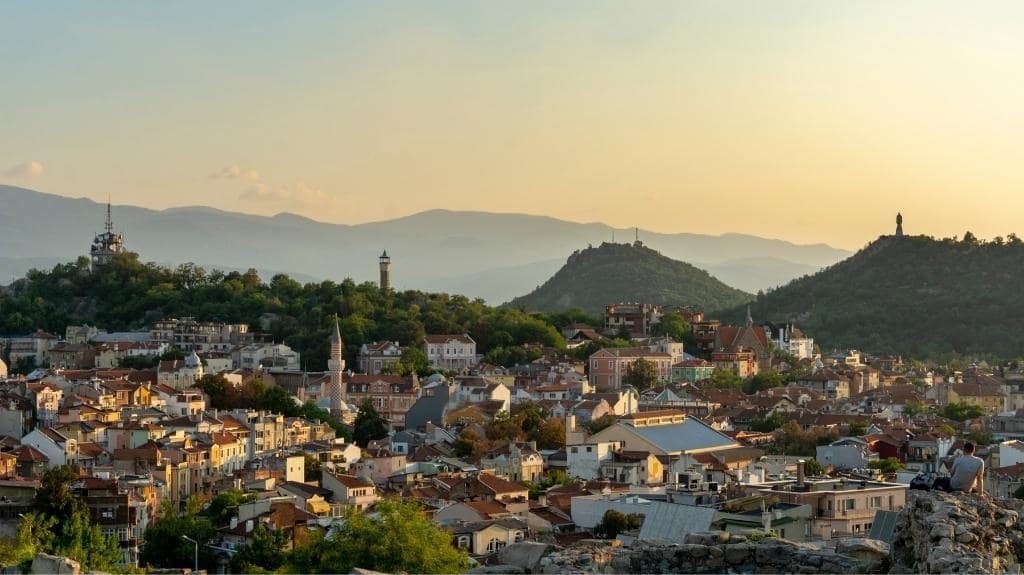
- Plovdiv sits on Seven Hills (Tepes). Plovdiv was originally built on seven hills (tepes). One of them – Markovo Tepe – was demolished in the early-20th century. Authorities used the stones to pave many of Plovdiv’s streets. The best view of the city is from the Bunardzhika Hill, measuring over 820 ft. (250 m) in height. There, you can also marvel at the imposing Alyosha monument that overlooks the city.
- Plovdiv prides itself on one of Europe’s oldest clocktowers. The clock tower on Sahat Tepe (Danov’s Hill) in Plovdiv dates back to 1623. This makes it one of the oldest clock towers in the world, 236 years older than the Big Ben in London. You can reach the tower with a short 5-minute walk from the Roman Stadium.
- Many sports legends call Plovdiv home. The list includes Bulgaria’s most popular football (soccer) player – Hristo Stoichkov – and the current women’s record holder in high jump – Stefka Kostadinova. Tsvetana Pironkova represents the younger generation, and is widely considered to be among the best grass-court tennis players.
- Plovdiv is Bulgaria’s cultural capital. The second-largest town in the country is also its cultural capital. In 2019, Plovdiv became the first Bulgarian city to be selected as a European Capital of Culture. During the same year, it hosted over 600 events. Whenever you visit Plovdiv, you’ll always find a cultural festival happening somewhere in the city.
Which of the Things Plovdiv Is Famous For Surprised You the Most?

This wraps up our list with 33 amazing things Plovdiv is known for.
The oldest town in Europe will enchant you with its quaint Old Town, ancient Roman and Thracian ruins, and indigenous red wines.
If you’re staying in the Bulgarian capital, a day trip from Sofia to Plovdiv is a great way to explore the country’s second-biggest city.
To make the most of your stay in Plovdiv, don’t forget to book your accommodation in advance.
Now, we’re curious:
What’s the first thing that comes to mind you when you hear Plovdiv?
Let us know in the comments below.
